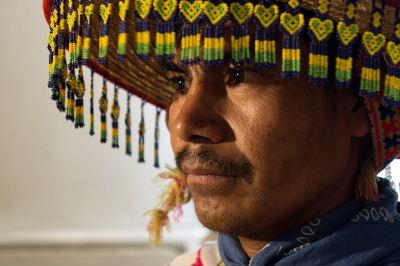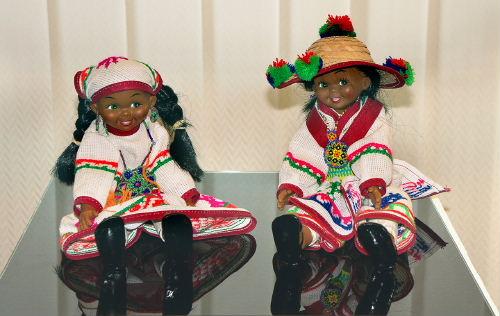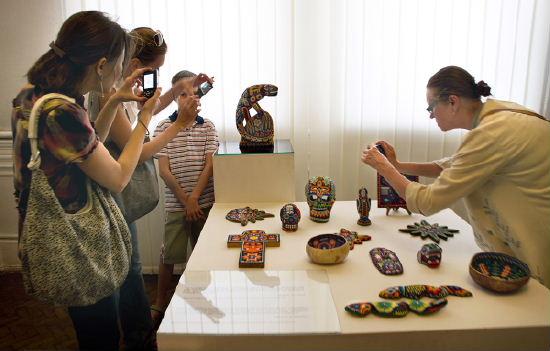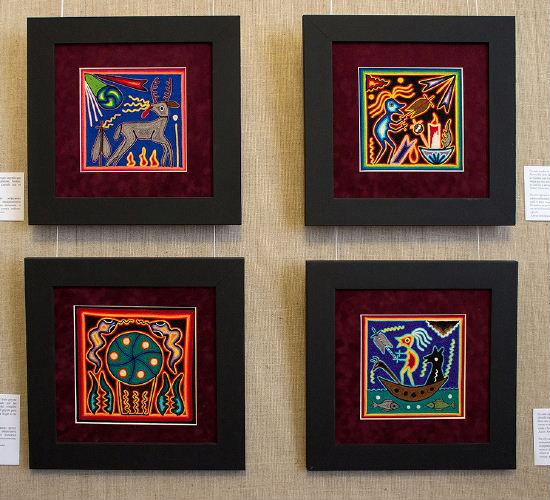|
| 
Search
All presented exhibitions
|
|
 |
 |
 |
“The Huicholes are an artistic people. This becomes abundantly clear just by looking at the wide range of aesthetic objects they create: the beautiful traditional costume, elaborately decorated gourd bowls, ritual arrows, basketry and textile work, an even the way they paint their faces before embarking on a pilgrimage”.
Margarita de Orellana
Margarita de Orellana, historian and Mexican editor. Director of the Publishing house “Artes de México”.
|
 |
The Embassy of Mexico in Ukraine presents in the National Ukrainian folk decorative art museum the exhibition "Arte Huichol" of traditional art of the indigenous Mexican people Huicholes
The Huicholes - Wixaritari or Wixarika - have a very particular way of preserving their ancestral culture. While zealously defending their lands and traditions, the members of this ethnic group have remained open to contact with the outside world, thus avoiding the trap of over protectiveness that can only lead to cultural stagnation. Especially in recent decades, Huichol artists have been developing new kinds of artistic expression with truly surprising results. This has led to the birth of art forms that combine ancient and modern elements, demonstrating that these creators possess a living, dynamic culture.
|
 |
 Pascual López Ramírez, the artist-artisan from the Huicholes community of Puerto Guamúchil
|
 |

|  |
The art of Huicholes is unique among cultural diversity of more than 60 nationalities which coexist in Mexico. It is unique due to its exquisite embroidery, textile goods and finesse of their ritual items, bedecked with beadwork, peculiar to artworks and domestic articles of Huicholes.
|
Mexican folk art is many-sided. It is tightly bound with cultural features of rural life, the underprivileged areas of cities, numerous Indian ethnic groups.
It have absorbed all influences that the country had underwent during ages and became an alloy of different cultural traditions: Europian, Arabic, peoples of Maya and Aztecs. And this adds their artworks their own very special colouring.
Likewise the Ukrainian folk decorative artworks, the articles of Mexican artisans are produced mainly at home for their own needs and serve as utensils, but they also may have aesthetic or ritual purposes.
At the opening ceremony, Pascual López Ramírez was present, who is the artist-artisan from the Huicholes community of Puerto Guamúchil, state Durango.
He had mastered this art, learning it directly from Wixarika artisans, and had been a Governor of the Huicholes community and the Attendant at the Jicareros during wixarika ceremonies (Jicarero is the attorney of one of sacral cups, which are stored at different sanctuaries of the ceremony center).
His artworks represent the cosmogony and traditions of the Huichole people in the form of decorative representation of maize (Indian corn), eagle, deer, peyote (hallcinogenic cactus), flowers, scorpions, snakes and many other forms and characters.
The exhibition helps to gain insight into originality of Mexican people, to be carried away to the Mexican lend, and have a better sensation and understanding of it.
 |
 Fragment of the exposition.
|
 |
 Fragment of the exposition.
|
Photo by Nikolay Mandrych
The Huicholes -Wixaritari or Wixarika- have a very particular way of preserving their ancestral culture. While zealously defending their lands and traditions, the members of this ethnic group have remained open to contact with the outside world, thus avoiding the trap of over protectiveness that can only lead to cultural stagnation. Especially in recent decades, Huichol artists have been developing new kinds of artistic expression with truly surprising results. This has led to the birth of art forms that combine ancient and modern elements, demonstrating that these creators possess a living, dynamic culture.
The Huicholes’ traditional territory in the Western Sierra Madre extends into four different states: Jalisco, Nayarit, Durango and Zacatecas.
In the late nineteenth century practitioners of an incipient anthropological science, started to find out about the Huicholes who immediately captured researchers’ attention for their fine needlework and weaving and for the sophistication of their ritual objects, including stone sculptures, votive arrows and gourd bowls decorated with beads.
Since 1960 the knowledge about wikarika art spread when craft production centers began to be set up outside of the Sierra, in the States of Nayarit, Jalisco, Zacatecas, San Luis Potosi, Nuevo León and Mexico City.
At the same time, Huichol artworks are continuing the pictorial tradition of pre-Hispanic codices, while dialoguing with modern and contemporary artists such as Kandinsky, Miró and Harring. Perhaps the paintings’ biggest attraction lies in that dual affinity. Unlike avant-garde creators, who are inspired by ethnic styles to recover an ancient aesthetic intuition that was thought to be lost, Huichol art preserves the Mesoamerican ancient world without any major ideological ruptures.
Huichol art is often presented as shamanistic art, due to the presence of peyote or other hallucinogenic plants in its iconography, or to its representation of the mara’akate in action: shamans wielding feathered wands and other paraphernalia. The Huichol religion, as part of the Mesoamerican tradition, sustains an elaborate mythology and a complex ceremonial system. Huichol art does have shamanistic and ceremonial characteristics but because they are the product of the vision quest undergone by the artist when still an initiate.
For wixarika, each figure is a powerful being with a will of its own. These are gods engaged in creating the universe at the very moment at which they appear in a work of art. Creating a work of art implies a commitment to participation in the rites and pilgrimages required by traditional Huichol religion.
The Huichol cosmovision is in fact an invisible curtain separating the non-initiates from the initiates: inaccessible to some, surpassed by others.
Johannes Neurath
Johannes Neurath (Vienna, Austria, 1965) Researcher at the National Institute of Anthropology and History of Mexico (INAH). Curator of the Gran Nayar room at the National Museum of Anthropology. Since 1992, has been doing field work with the huicholes and coras.
Extract of the text published in the magazine “Artes de Mexico”, No. 75, 2005.
Huichol art and crafts derive from ritual art, especially ceremonial objects like gourd bowls (xukurite) and small yarn paintings (wewiya). However, not all traditional or ritual techniques are used in craft production.
Painting on different surfaces is just one of the techniques reserved for ritual use.
A very different pigment is used in for ceremonial arrows, one in red and “dark” colors such as blue or black. The designs represent the prayers sent to the gods by means of these arrows.
Huichol sculpture – both the relief carvings on the sacrificial discs (tepalite) and the figures of gods and sacred animals – is also specifically ritual, especially when made of stone.
The decoration of idols in usually done with yarn or beads, and is renewed periodically. Nonetheless, pieces that are completely covered with multicolored beads or yarn are generally sold as crafts.
The favorite techniques of the Huicholes are textiles and appliqué work. Examples of Huichol textiles include hats woven from soyate palm fiber. The two-toned bags and sashes tha form part of traditional Huichol dress are woven on back straps looms from acrylic yarn or wool. Bags and clothing made from blankets are embroidered in cross-stiches with multicolored thread, while personal accessories (necklaces, bracelets and earrings) are made with threaded beads.
Appliqué work is done with a diversity of multicolored materials and attached with wax to two –and three- dimensional pieces. The most common bases for ceremonial objects are wood or bottle gourds.
The production of ritual objects and those destined for sale reveal important differences. Unlike ritual gourd bowls, commercial ones utilize a brighter color scheme and their surfaces are entirely adorned with geometric and symmetric designs, often hexagonal. The figures in the pieces destined for sale are arranged similarly to those seen in cross-stitch embroidery done by Huichol women. Ritual objects, do not share the geometric and symmetric designs of the crafts.
Materials such as wax, beads, wool and cotton make ceremonial objects and offerings sacred. Beads, for instance, symbolize water, which is why they cover the inner surface of gourd bowls, excellent natural water containers. Nowadays, beads are sacred among Huicholes. According to them –in particular women with experience in the production of ritual gourd bowls- beads mean life. These small beads are also compared to kernels of corn. As the basis of the Huichol diet, corn is an important symbol and is often used in rituals, for purification, for example.
The most successful Huichol art objects are the yarn paintings that reflect their symbolism and mythology. They also possess a symbolism as textiles. The cosmic mythology of the Great Nayar explains how the world itself is a textile woven from the hair of the first goddess. After spreading wax over the surface of the board, the contours of the design are drawn. The application of yarn begins with the border usually consists of three multicolored stripes. Figures are outlined and then filled in. The artist signs the back of the piece, often adding a brief explanation of the work’s symbolism.
Johannes Neurath and Olivia Kindl
Johannes Neurath (Vienna, Austria, 1965) Researcher at the National Institute of Anthropology and History of Mexico (INAH). Curator of the Gran Nayar room at the National Museum of Anthropology. Since 1992, has been doing field work with the huicholes and coras.
Oliva Kindl (Paris, France, 1969). Researcher of the Institute of Anthropologic Research of the National Autonomous University of Mexico.
Extract of the text published in the magazine “Artes de Mexico”, No. 75, 2005.
Content-type: text/html
CGI Error
CGI Error
Cannot open file 'msid_DB': No such file or directory
|